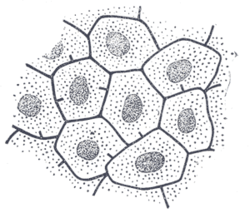| Bile canaliculus | |
|---|---|
 Bile capillaries of rabbit (shown by Golgi's method with 450 x magnification) | |
| Details | |
| Identifiers | |
| Latin | canaliculi biliferi |
| MeSH | D001648 |
| Anatomical terminology | |
A bile canaliculus (pl.: bile canaliculi; also called bile capillaries) is a thin tube that collects bile secreted by hepatocytes. The bile canaliculi empty into a series of progressively larger bile ductules and ducts, which eventually become common hepatic duct. The bile canaliculi empty directly into the canals of Hering.
Hepatocytes are polyhedral in shape, therefore having no set shape or design, although they are made of cuboidal epithelial cells. They have surfaces facing the sinusoids (called sinusoidal faces) and surfaces which contact other hepatocytes (called lateral faces). Bile canaliculi are formed by grooves on some of the lateral faces of these hepatocytes.
Microvilli are present in the canaliculi.[citation needed]
External links
[edit]- Bile+Canaliculi at the U.S. National Library of Medicine Medical Subject Headings (MeSH)
- UIUC Histology Subject 421
- Histology image: 15301loa – Histology Learning System at Boston University
Well, that’s interesting to know that Psilotum nudum are known as whisk ferns. Psilotum nudum is the commoner species of the two. While the P. flaccidum is a rare species and is found in the tropical islands. Both the species are usually epiphytic in habit and grow upon tree ferns. These species may also be terrestrial and grow in humus or in the crevices of the rocks.
View the detailed Guide of Psilotum nudum: Detailed Study Of Psilotum Nudum (Whisk Fern), Classification, Anatomy, Reproduction